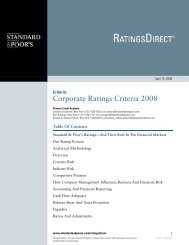European Infrastructure Finance Yearbook - Investing In Bonds ...
European Infrastructure Finance Yearbook - Investing In Bonds ...
European Infrastructure Finance Yearbook - Investing In Bonds ...
Create successful ePaper yourself
Turn your PDF publications into a flip-book with our unique Google optimized e-Paper software.
UTILITIES<br />
26 ■ NOVEMBER 2007<br />
supply risk) and obtaining control of municipally<br />
owned electricity and heat distribution networks<br />
(to provide a base of stable, network earnings and<br />
improve operations). However, the potential<br />
degree of diversification is limited by the legal<br />
prohibition of simultaneous ownership of<br />
“monopoly” (transmission, electricity distribution,<br />
and dispatching) and “competitive”<br />
(generation and supply) assets within one market<br />
price zone. The two power market zones are<br />
Europe and the Urals, and Siberia. This law<br />
prohibits the vertically integrated generation and<br />
distribution structures typical of <strong>European</strong><br />
power utilities.<br />
Diversification, the potential synergies, and<br />
hedging opportunities should support the interest<br />
of gencos and their strategic minority investors to<br />
invest in supply companies, all of which UES<br />
plans to sell in 2007-2008. A combination of<br />
wholesale generation and supply should reduce<br />
overall business risk through diversification of the<br />
customer base and higher customer loyalty. This is<br />
likely to result in lower competitive pressure and<br />
reduced customer attrition, as well as higher<br />
margins in retail electricity sales. At the same<br />
time, on their own, electricity supply operations<br />
have the highest business risk in the electricity<br />
value chain.<br />
A Whole New Wholesale System<br />
<strong>In</strong> September 2006, Russia introduced new rules<br />
for its electricity market that are a big step<br />
toward full deregulation of wholesale power. <strong>In</strong><br />
place of the old regulated pool system, where<br />
generators sold power at cost-based rates and<br />
received regulated payments for fixed capacity<br />
costs, the new market is based on bilateral<br />
regulated contracts between generators and<br />
wholesale customers, which initially covered 95%<br />
of planned generation volumes. Generators sell<br />
any volumes not covered by regulated contracts,<br />
and customers sell any surplus power from<br />
regulated purchases on the deregulated spot<br />
market. Actual supply/demand dynamics<br />
determine the deregulated market’s share.<br />
The government intends to deregulate the<br />
market and reduce volumes sold under regulated<br />
contracts. <strong>In</strong> April 2007, it approved a new<br />
deregulation plan that would fully evolve from<br />
2007 to 2010 (see chart 3). This is well ahead of<br />
previous plans that had a seven- to 20-year<br />
time frame.<br />
STANDARD & POOR’S EUROPEAN INFRASTRUCTURE FINANCE YEARBOOK<br />
The contracts have “take-or-pay” terms (that is,<br />
buyers will make payments to the electricity<br />
wholesaler for the contract electricity volume<br />
regardless of their actual power demand). Since<br />
2008, the contracts will also have an automatic<br />
adjustment for passing fuel costs on to customers<br />
and an annual adjustment to regulated rates for<br />
other increasing costs through an inflationbased<br />
formula.<br />
<strong>In</strong> the new market model, a generator also<br />
recovers fixed costs through regulated bilateral<br />
contracts. The government plans to deregulate<br />
capacity payments in line with the spot market by<br />
reducing the portion of generation capacity<br />
covered by regulated payments. Wholesale market<br />
participants will have to procure capacity<br />
covering their peak demand, minus capacity paid<br />
through regulated contracts from generators<br />
through a market-based mechanism. The first<br />
auction is likely in 2007 for capacity to be<br />
delivered in 2008 and 2012.<br />
Exposure to spot price volatility will grow in line<br />
with market deregulation<br />
Seasonal, daily, and intraday power-demand<br />
variations make spot electricity prices highly<br />
volatile (see chart 4 on next page). While gencos’<br />
current exposure to the spot price is limited<br />
because only 10% of the wholesale market has<br />
been opened, this exposure will increase in line<br />
with wholesale market deregulation and will<br />
reach 100% by 2011.<br />
Spot-price deregulation for generators in<br />
<strong>European</strong> Russia and in the Ural region has been<br />
positive to date (see chart 5 on next page).<br />
Chart 3<br />
Russian Wholesale Market<br />
Deregulation Schedule



